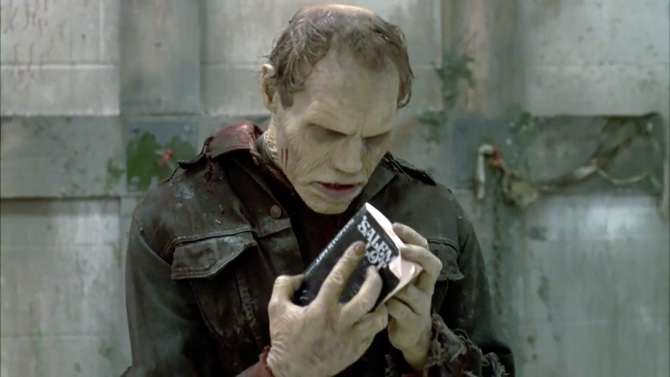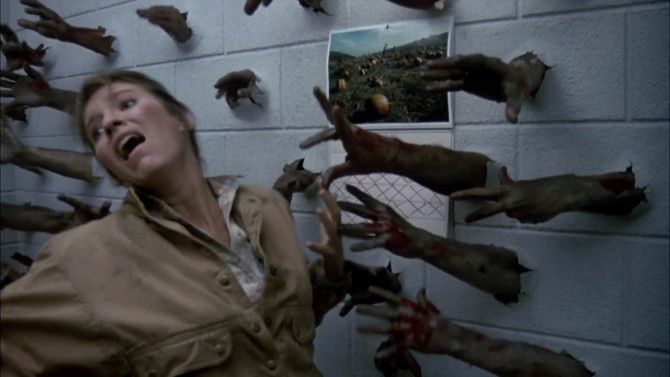They first appeared late one night, which then led to the dawn of a new, more frightening day. . . now, they own said day – the third in George A. Romero’s anthology zombie franchise, 1985’s Day of the Dead finds a small group of desolate individuals attempting to survive the ever growing and encroaching human eating hordes, a task that is easier said than done.
Featuring a three pronged attack, Romero (who writes and directs) utilizes touches of German Expressionism, 60s psychological horror (think Roman Polanski’s Repulsion) and brutal gore to keep his audience on its toes. Our survivors are cloistered away in an underground military camp – a ragtag team pieced together in the final days of organized chaos to search for some sort of cure for the growing number of undead. They do, from time to time, head out in their helicopter, searching for survivors – the famed Edison theatre in Fort Myers, Florida, can be seen in the opening sequence.
Comprised of three doctors: outspoken protagonist Dr. Sarah Bowman (Lori Cardille), the restrained Dr. Fisher (John Amplas), and Dr. Logan (Richard Liberty) – a man who has been given the ominous moniker of Frankenstein (due to his out-there experiments); a group of military personnel: the leader of the operation – Captain Henry Rhodes (Joseph Pilato), his right hand man Pvt. Steel (Gary Howard Klar), Steel’s best bud Pvt. Rickles (Ralph Marrero), Bowman’s boyfriend, Pvt. Miguel Salazar (Anthony Dileo Jr.), Pvt. Johnson (Gregory Nicotero), as well as several others; while helicopter pilot John (Terry Alexander) and radio operator Bill McDermott (Jarlath Conroy) round out the team.
Dealing with the mental strain of the ever growing situation, the team slowly begin to turn on each other. Whether looking at the romantic relationship of Bowman and Salazar, the lack of trust the non military personnel feel towards the soldiers, or the keep-out-of-everything attitude of John and Bill, a lack of communication, sense of community and coordination allows divisiveness to take hold, factions to grow amongst them, and people to slowly become unhinged. Romero’s socially aware feature speaks to the struggles of coming together as a nation (as this small group is, in many ways, like a little nation), the mistrust of the military (and its industrial complex), and a general malaise that crept into the psyche of the Populus at the time.
Though they are in a decent situation, all things considered (surrounded by fences and living underground, with plenty of food and water, weapons and people to work for), it is those within the perfectly structured locale that bring it down. The biggest clash comes from Bowman and Rhodes, the lone woman looking for unity and a progressive outlook from the military faction, while the Captain is almost like a Kurtz-type character – a petty tyrant with a mental complex and “Heart of Darkness”. Eventually, each and every person will have to make a choice, whether to follow one or the other, stand up for what is right or sit back and go with the flow, stick to their scientific endeavours or scrap the plan, stay in their crypt-like compound or head out into the world of the undead.
Visually, Romero constructs a realistic landscape of a post-apocalyptic future (it doesn’t hurt that the underground facility was built in the Wampum mine, a former limestone mine near Pittsburgh). Originally planned to be much bigger (closer to his 2005 feature Land of the Dead), the three and a half million dollar budget made him narrow his vision, a more claustrophobic, confined tale that helped build a more palpable atmosphere. Featuring a number of dream sequences (that symbolize the lack of safety and utter fear that has seeped into the conscious and unconscious minds of the few remaining survivors), it is quite reminiscent of the aforementioned Repulsion. Though the brutal gore must be mentioned (impressively squeamish moments designed by Romero, effects guru Tom Savini, and for those The Walking Dead fans, you may have already noticed the name Greg Nicotero above – this is the same mastermind who directs, produces and develops the special effects makeup for the series – he was Savini’s assistant on Day of the Dead), much of the film’s successes come from its use of shadow and light, psychological horror and suspense – those slowly creeping zombies that we see before our protagonists.
Intriguingly, Romero also furthers the zombies’ intellect, their longer existence bringing with it concepts of fear and apprehension. . . while Dr. Logan’s star pupil, Bub (Sherman Howard), is able to recall past experiences prior to zombification, Logan finding a semblance of control in a creature that is not supposed to have any (he salutes, can recall firing a gun, and can echo speech, to name but three things he has learned). It suggests both hopeful and frightening possibilities.
The third of six Romero zombie films, Day of the Dead is a worthwhile entry into the franchise. Though often falling behind the original two when ranked, it is a quality piece of horror film making – featuring a fascinating story, superlative practical special effects, a suspenseful setting and solid score (by John Harrison) that makes it well worth another analysis. So, instead of hitting the beach this summer, corral a copy of this classic zombie motion picture, it comes with my well earned salute.


